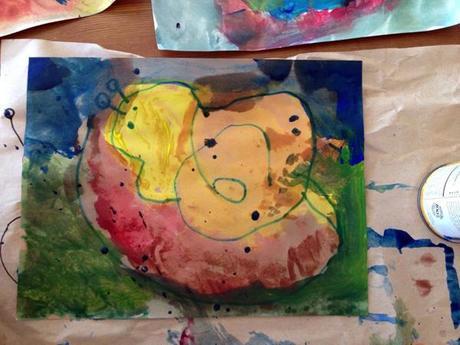At the recent artists’ conference I attended, I had the privilege of hearing several great speakers. One of them was figurative painter F. Scott Hess who teaches at the Laguna College of Art & Design.
I thought I’d share a few of my notes from his talk about how to create visual movement in paintings. I realize it won’t make as much sense for you without the corresponding slide show and elaboration, but nonetheless I think these brief notes will be interesting to painters and anyone interested in the kind of deliberate thought that the artist sometimes must use when composing a painting.
Some methods for creating movement:
- Association. For example, if you see the form of a dancing person, you assume movement.
- Instability. Purposely create a composition that is off-balance. The viewer’s brain unconsciously wants to move things around to restore the missing balance, which creates feeling of movement.
- Enactment or Succession–create a pattern of movement across the image going from one object to the next.
- Striving Forces. Elements within a painting that fight each other or attract each other. For example, partially block an object in the painting with another object, making the viewer’s brain want to move it in front. Or use structural ambiguity by skewing forms to create a kinetic sensation.
- Flicker & iridescence. To create flicker, create a harsh breakup of color and light with opposite colors right next to each other, which is good for a sense of speed and tempo. To create iridescence, use a much narrower range of tone and color. Iridescence is a great way to show the flow of water or wind.
- Discombobulation. Create confusion by taking things apart into pieces or removing forms from their outlines.
- Viewing. Control what the viewer looks at. Most people look from left to right. If movement goes right to left its psychologically harder for the viewer to process the image. Use both to create movement or clash. You can also lift things against gravity to create movement, or use depth so things appear to be moving away from you or towards you.
- Path of Movement. Put a path in the painting for the viewer’s eye to follow. Anything you place on that path will have movement.
One of my paintings that I think has great movement in it is Pollination:

Pollination. 24″ x 72″, Oil on Canvas. © Cedar Lee 2012
Also speaking that day was Glenn Brill, who gave an excellent talk and demonstration about Gamblin oil colors, mediums and solvents, complete with color theory and a lot of nitty-gritty details about the chemistry of painting. I’m not going to go into all of that here, but wanted to share this one thing he said that I jotted down (paraphrased):
“Because painting requires constant problem-solving, painters have the mental agility to do any profession.”
Totally unrelated brag moment: Check out what my son painted the other day. It’s a snail on a rock!

I wanted to test out a lesson plan for the upcoming art lessons I’ll be teaching to local children. So on this day, instead of just letting him play with paint undirected, which is what I usually do, I gave him his first official art lesson. I taught him how to mix paint and create a color wheel, then do a line drawing with marker and use all the different colors to fill in the shapes of his drawing. Not too shabby for a 3 1/2-year-old!
